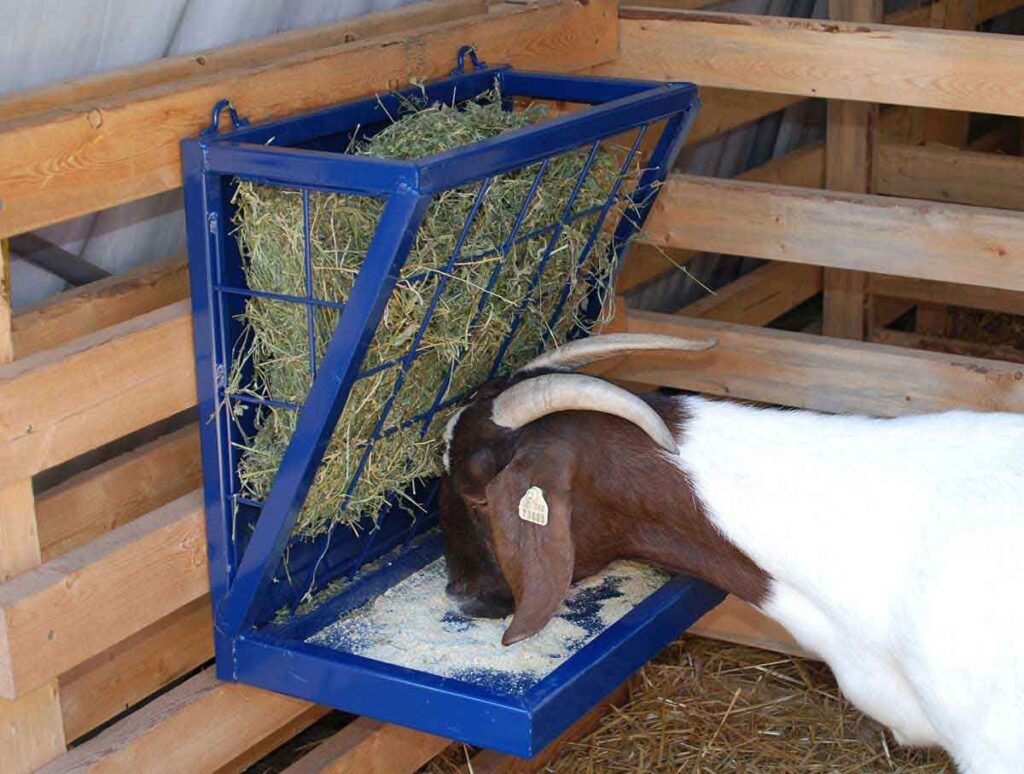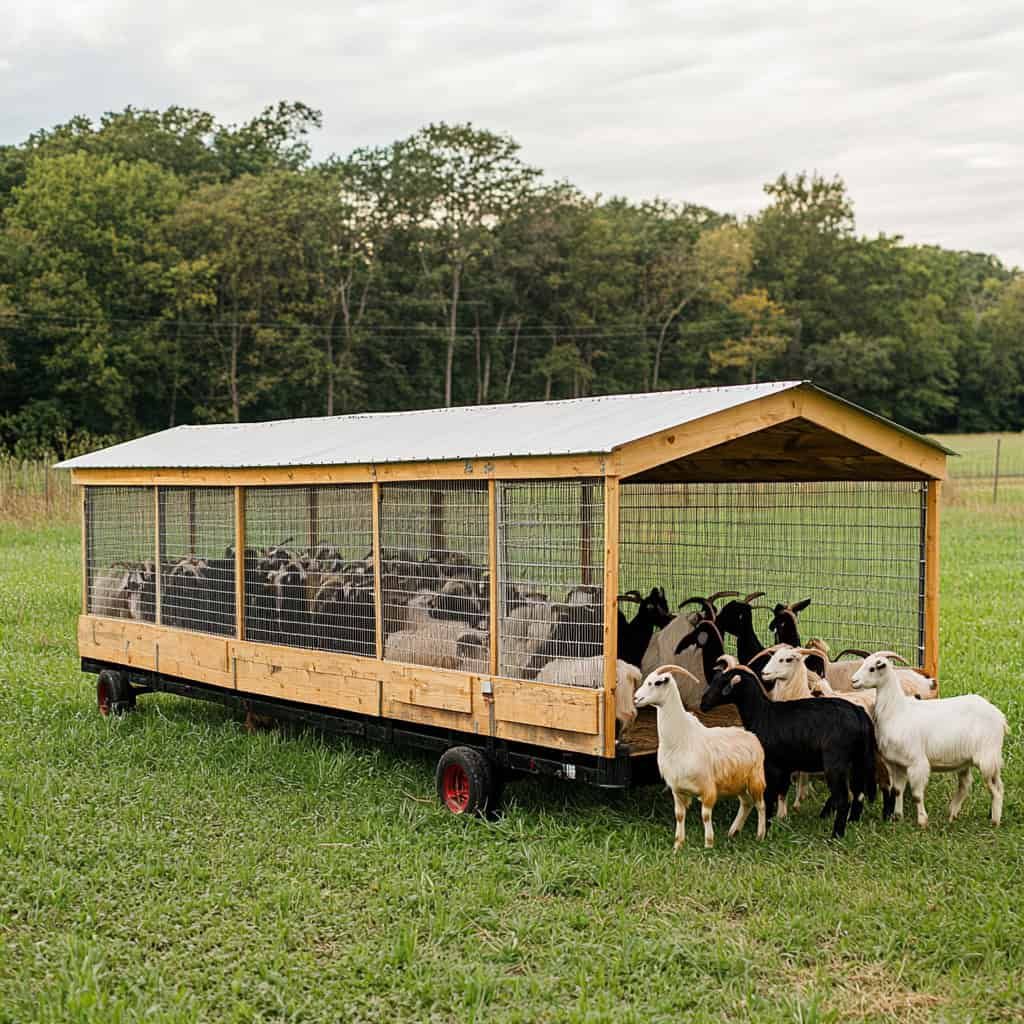Goats do well with good pasture alongside fresh water; however, a thoughtfully designed goat hay feeder matters significantly. This minimizes lost food, supports proper eating habits, also promotes overall health. Good hay feeders shield forage from grime or moisture, ultimately saving money. Here’s a guide detailing choices for goat hay feeders – the styles available, construction materials, options to construct versus purchase, plus maintenance tips ensuring longevity.
Why a Quality Goat Hay Feeder Matters
Goats munching hay straight from the dirt? It’s messy – lots get wasted, things contaminate it, plus parasites move in. A good hay feeder keeps their food supply clean and steady. Consequently, they eat better, while you lose less hay to being stepped on or dirtied up; this boosts how well your farm runs.
A well-made hay feeder for goats cuts down on squabbles, so every goat can dine peacefully – no getting hurt or worked up.
Types of Goat Hay Feeders
Goat hay feeders come in many forms – some work better depending on how many goats you have, where you live, or simply what they like to eat. Knowing what each one does well, also its drawbacks, will guide you toward the right choice for your animals.
1. Wall-Mounted Hay Feeders
Perfect for barns and covered shelters, wall-mounted goat hay feeders are installed at goat shoulder height to prevent hay from falling to the ground. They are easy to fill and ideal for smaller herds. Stainless steel or heavy-duty galvanized metal designs are best for longevity and ease of cleaning.
2. Free-Standing Hay Feeders
Got goats? A free-standing hay feeder goes wherever they do – perfect for moving them around pastures or keeping them contained. Usually built with angled holders, it cuts down on wasted feed. It’s tough, rolls easily, so several goats can eat simultaneously.
3. Combination Hay and Grain Feeders
Goats can eat hay up top, also grains or pellets down below with these handy feeders. It’s a combined system so feed stays neat, meaning less work for you spreading things around.
4. Slow Feed Hay Nets
To manage what goats eat, inexpensive hay nets or bags work well instead of traditional feeders. These tools control how much they consume, stop gorging, then encourage a more typical way of foraging. Still, make sure these are firmly attached – check them often to keep goats from getting tangled.
5. Round Bale Feeders
Goats in sizable groups do well with robust round bale feeders – they accommodate whole bales. Built for being outside, these work especially nicely through cold months. Just be certain any feeder you select is made for goats so they don’t get their heads stuck.
Key Features to Look for in a Goat Hay Feeder

A good goat hay feeder – whether you buy one ready-made or construct it yourself – hinges on a few key details to keep things running smoothly while safeguarding your animals.
- Built to last – pick from robust galvanized steel, a protective powder coat over metal, or tough plastic that can handle anything the weather throws at it, as well as rambunctious goats.
- To cut down on mess – also keep goats out of trouble – position a hay feeder so it reaches about their shoulders.
- To cut down on waste, consider designs featuring angled walls, collection containers, or restricted spaces – these help keep hay where it belongs, instead of scattered about.
- Refills are a breeze – it’s designed for simple cleaning too. Broad access points alongside sleek finishes make everyday upkeep uncomplicated.
- Keep goats safe! Steer clear of pointy bits, tight squeezes, or openings where they might get stuck.
DIY Goat Hay Feeder Ideas
For small farms or homesteaders, building a DIY goat hay feeder can be a budget-friendly and practical solution. Here are a few simple ideas:
1. Pallet Hay Feeder
Turn old wood pallets into a robust, earth-kindly hay rack for goats. Slice openings so they can extract hay – but not massive handfuls.
2. Trough and Mesh Design
A metal trough goes under the wire rack. It gathers stray hay so goats can snack without trouble.
3. Barrel Feeder
A big plastic drum becomes a handy goat feeder when you slice holes around its middle then stuff it full of hay. It’s light enough to move where needed, moreover cleaning isn’t hard.
Tips for Efficient Hay Feeding
Get goats thriving – better nutrition means healthier animals. Here are some tips from those who know
- Goats do best when fed tender hay – alfalfa or a blend of grasses works well because they like softer leaves.
- Goats nibble constantly – they’re built that way. So, always ensure a full supply of good, dry hay is available.
- Keep bird feeders dry – either put them where rain doesn’t reach, or choose ones that have a roof, so the hay stays good.
- Keep things tidy! A weekly clean stops grime from gathering, meaning fewer chances for sickness to spread.
- Watch how much hay the animals eat – this helps fine-tune their diet while cutting down on leftovers.
Benefits of Using the Right Goat Hay Feeder
Goats – as well as those who raise them – really benefit from a good hay feeder. It simply makes life easier for everyone involved
- Less hay goes to waste – perhaps 30 to 50 percent less – because animals don’t stomp on it or soil it as much.
- Goats thrive on clean hay – less chance of parasites, improved tummies. It’s that simple.
- You’ll spend noticeably less time on chores like cleaning up messes or restocking supplies – meaning more free hours each day.
- Spending less on hay means reduced feeding expenses eventually.
- A clean eating space discourages bugs while also controlling dampness.
Maintenance and Longevity
Keep your goat’s hay feeder going strong with simple upkeep. Check often for rust, wobbly parts, or anything pointy that might injure them. For wood feeders, a coat of protective sealant does wonders. Fix damaged screens or grilles without delay. Regular maintenance preserves strength alongside security, delivering lasting benefit from what you’ve bought.
Choosing the Best Goat Hay Feeder for Your Herd
Figuring out the best way to feed goats hay hinges on how many you have, where they live, also what you can spend. Smaller places might like feeders you hang up or build yourself; bigger operations often do well with those for round bales. Keeping things simple, safe, moreover protecting the hay itself should matter more than looks or a low cost.
A good hay feeder for goats means better farming – less wasted food, more savings, healthier animals. It’s that simple.
Conclusion
Good hay feeders for goats? They’re worth the expense – healthier animals, less wasted food, tidier shelters. Buy one ready-made or construct your own, but prioritize keeping goats safe, making things work smoothly, also minimizing mess. A well-designed feeding system means a better, busier, cheerful goat farm.



1 Comment
Pingback: Discovering the Fascinating World of Chameleónovité: Nature’s Masters of Color and Adaptation 2025 - My Blog